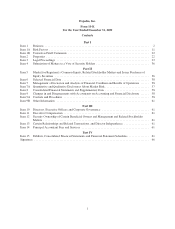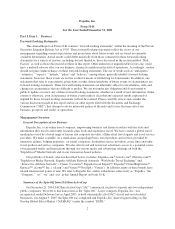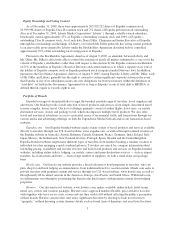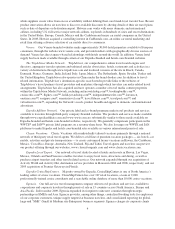Expedia 2009 Annual Report Download - page 15
Download and view the complete annual report
Please find page 15 of the 2009 Expedia annual report below. You can navigate through the pages in the report by either clicking on the pages listed below, or by using the keyword search tool below to find specific information within the annual report.markets represent especially large opportunities for Expedia and those of its competitors that wish to expand their
brands and businesses abroad.
Our competition, which is strong and increasing, includes online and offline travel companies that target
leisure and corporate travelers including travel agencies, tour operators, travel supplier direct websites and their
call centers, consolidators and wholesalers of travel products and services, search engines and travel meta-search
engines. We face these competitors in local, regional, national and/or international markets. In some cases,
competitors are offering favorable terms and improved interfaces to suppliers and travelers which make
competition increasingly difficult.
We believe that maintaining and enhancing our brands is a critical component of our effort to compete. We
differentiate our brands from our competitors primarily based on quality and breadth of travel products, channel
features and usability, price or promotional offers, traveler service and quality of travel planning content and
advice. The emphasis on one or more of these factors varies, depending on the brand or business and the related
target demographic.
Our brands face increasing competition from travel supplier direct websites. In some cases, supplier direct
channels offer advantages to travelers, such as long standing loyalty programs, no transaction fees and better
pricing. Our websites feature travel products and services from numerous travel suppliers (as opposed to a single
supplier), and allow travelers to combine products and services from multiple providers in one transaction. We
face competition from airlines, hotels, rental car companies, cruise operators and other travel service providers,
whether working individually or collectively, some of which are suppliers to our websites. Our business is
generally sensitive to changes in the competitive landscape, including the emergence of new competitors or
business models, and supplier consolidation.
Intellectual Property Rights
We regard our intellectual property rights, including our patents, service marks, trademarks, domain names,
copyrights, trade secrets and other intellectual property, as critical to our success. For example, we rely heavily
upon the software code, informational databases and other components that make up our travel planning service.
We rely on a combination of laws, business practices and contractual obligations with employees, suppliers,
affiliates and others to establish and protect our trade secrets. Despite these precautions, it may be possible for a
third-party to copy or otherwise obtain and use our trade secrets or our intellectual property without authorization
which, if discovered, might require the uncertainty of legal action to correct. In addition, there can be no
assurance that others will not independently and lawfully develop substantially similar properties.
We maintain our trademark portfolio by filing trademark applications with the appropriate international
trademark offices, maintaining our current registrations, securing contractual trademark rights when appropriate,
and relying on common law trademark rights when appropriate. We also register domain names as we deem
appropriate. We protect our trademarks and domain names with an enforcement program and use of trademark
licenses. While we seek to protect our trademarks and domain names, effective trademark and domain name
protection may not be available or may not be sought by us for every trademark and domain name used in every
country, and contractual disputes may affect the use of trademarks and domain names governed by private
contract. In addition, our infringement monitoring resources may not locate every trademark or domain name
infringement that exists. Similarly, not every variation of a domain name may be available, or may be registered
by us, even if available. The failure to protect our intellectual property in a meaningful manner, or challenges to
our intellectual property rights, could materially adversely affect our business, result in erosion of our brand
names and/or limit our ability to control marketing on or through the internet using our various domain names.
We have considered, and will continue to consider, the appropriateness of filing for patents to protect future
inventions, as circumstances may warrant. However, many patents protect only specific inventions and there can
be no assurance that others may not create new products or methods that achieve similar results without
infringing upon patents owned by us.
9
























